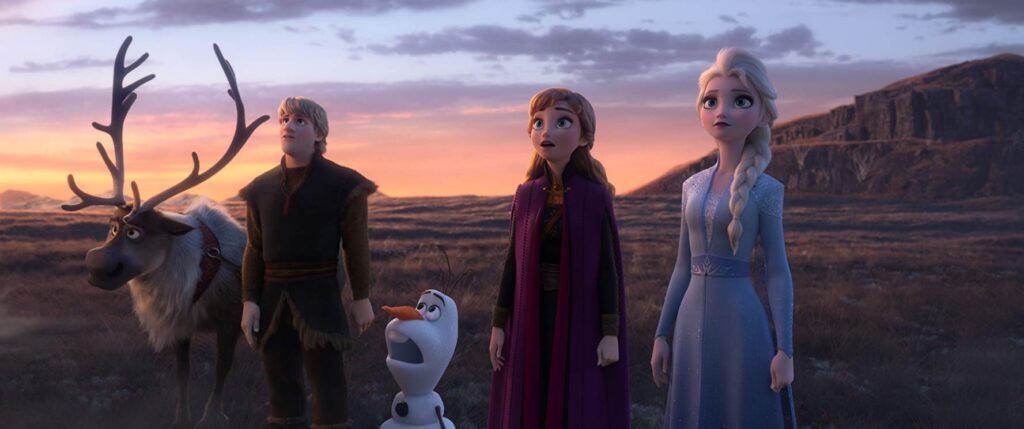Walt Disney Animation Studios boasts something of a shaky record when it comes to sequels: we’re not terribly far removed from the mostly dreadful straight-to-video releases that plagued the late 1990s and mid-to-early 2000s. That history no doubt added to the pressure placed on the filmmakers behind Frozen II, already saddled with the daunting task of crafting a worthy follow-up to one of the most successful animated films of all time. A worldwide gross of $1.2 billion, a soundtrack that went on to be come the top-selling album worldwide, and a Broadway adaptation are each massive legacies to live up to in their own right — and Frozen had all three.
Opening with a new arrangement of “Vuelie,” the same number that played over the credits of the original film, Frozen II whisks us back to the Arendelle of Anna and Elsa’s youth. King Agnarr (Alfred Molina) recounts a story from his childhood, about an enchanted forest inhabited by the spirits of earth, air, fire and water, and a peaceful race called the Northuldra, who learned to harness the gifts of the elements. The citizens of Arendelle lived alongside the Northuldra until a gathering of their peoples erupted into a fierce battle, angering the spirits and causing the forest to be sealed off by an impenetrable mist, with no one entering or leaving since that day.
Flash forward to the present, and Elsa (Idina Menzel) is settling into her new role as Queen of Arendelle, but finds herself haunted by the call of an ethereal voice that only she can hear. Using her magic to locate its origin, Elsa unwittingly releases the wrath of the elements, putting the citizens of Arendelle in danger and threatening the kingdom’s very existence. Knowing her people won’t be safe unless she can find a way to quell the raging spirits, Elsa enlists Anna (Kristen Bell), Olaf (Josh Gad) and Kristoff (Jonathan Groff) for a treacherous journey into the forest of legend, where she’ll come face to face with the secrets of Arendelle’s past — and her own destiny.
The original film struck a nice balance between the two sisters, but Frozen II is far more invested in exploring Elsa’s journey. Whether it’s because Elsa is the more complex and interesting character, or whether she merely seems that way because the filmmakers chose to provide her a more elaborate arc, is up for debate. What’s not in dispute is that Elsa gets the most onscreen action and the most compelling narrative — and naturally, the best songs. “Into the Unknown” may not be as instantly iconic as “Let It Go,” but it’s a fantastically catchy number, and “Show Yourself” is Menzel at her absolute best, accompanied by jaw-dropping visuals and a dazzling array of colors.

Curiously enough, it might just be Kristoff’s big solo, “Lost in the Woods,” that emerges as Frozen II‘s most memorable number. Frustrated by a series of failed attempts to ask for Anna’s hand in marriage, Kristoff wanders the forest and belts out the Disney equivalent of an 80s power ballad, guitar solos and all. The film even stages the number like a music video, with some hilarious visual references that include Kristoff and a trio of reindeer recreating the cover of Queen II. There’s an ample dose of humor throughout the film, but this sequence easily garnered the biggest laughs.
As for Anna, it feels as if the filmmakers weren’t sure what to do with her this time around. The aforementioned subplot with Kristoff’s numerous failed proposals provides a few laughs, but is devoid of any emotional resonance, and although Anna joins the rest of the main characters in Frozen II‘s first big number, “Some Things Never Change,” her third act solo feels terribly underwhelming, especially for a moment clearly meant to be climactic. Bell is still quite excellent in the role, and nails the emotional beats effortlessly — I just wish the script had given Anna something with a bit more meat on the bone instead of feeling so sparse.
It should come as little surprise that Olaf, the scene-stealing snowman from the previous film, is given significantly more screentime for the sequel. Gad once again balances Olaf’s sunny disposition and childlike wonder with deadpan one-liners and non-sequiturs, and goes for broke in a side-splitting gag that finds him delivering a dramatic re-enactment of Frozen‘s plot. Olaf also gets his own musical number, “When I Am Older,” where he ruminates on his inability to understand the events happening around him and chalks it up to his own lack of maturity — it’s cute, but lacks the comical punch of the previous film’s “In Summer.”
Realistically, Frozen II never really had a shot at toppling its predecessor, and anyone thinking it might surpass the original would be wise to temper their expectations. Frozen was lightning in a bottle, shattering box office records and exceeding the loftiest of Disney’s own expectations on its way to becoming a bona fide cultural phenomenon. But returning directors Jennifer Lee and Chris Buck have done an outstanding job with this follow-up, giving fans more of the things they loved in the original film while expanding the world and exploring the characters in spellbinding new ways. Pixar films notwithstanding, this is the best animated sequel Disney has released in years — maybe ever — and much like the mysterious voice that Elsa seeks, the call of Frozen II is irresistible.
For more on Frozen II, click here to read our interview with supervising animator Justin Sklar.

